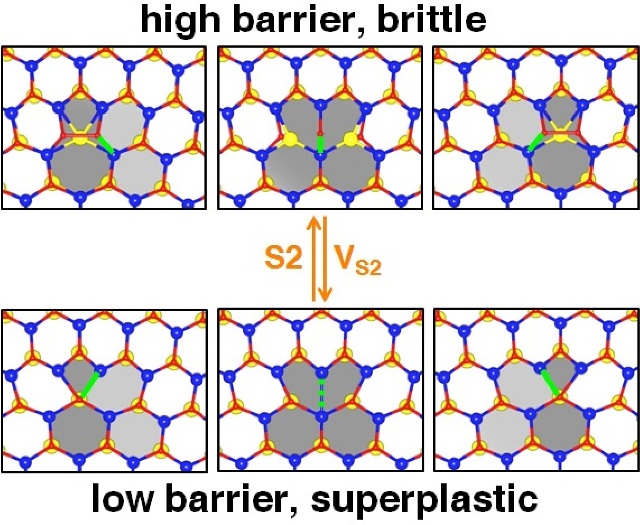May 5 2015
来自Rice University已经分析了2D二甲藻元化的特性 - 二硫化钼 - 发现其原子较薄的层可以在特定压力和温度下具有硫磺气体的存在下采用塑料的特性。
 赖斯大学科学家的计算表明,二维二硫化二硫层可以通过改变其环境条件而变得极端。在具有硫的大气中,在适当的温度和压力下,降低了能屏障,从而使沿晶界的位错移动和改变了材料的性质。S2是指二硫分子;VS2是两个硫磺原子空缺。(信用:小祖/赖斯大学)
赖斯大学科学家的计算表明,二维二硫化二硫层可以通过改变其环境条件而变得极端。在具有硫的大气中,在适当的温度和压力下,降低了能屏障,从而使沿晶界的位错移动和改变了材料的性质。S2是指二硫分子;VS2是两个硫磺原子空缺。(信用:小祖/赖斯大学)
The Rice research team was led by Boris Yakobson, theoretical physicist, and Xiaolong Zou, postdoctoral researcher. Their finding showed that molybdenum disulfide could be deformed without necessarily breaking it. This could be of immense interest to materials scientists working on 2D materials. The study has been published in the American Chemical Society journal Nano Letters.
The key reason for choosing molybdenum disulfide, an already well-researched material thanks to its semiconducting properties, for this study was the interesting structure of its grain boundaries. While 2D materials such as graphene are flat sheets, 2D molybdenum disulfide has molybdenum atoms sandwiched between two sulfur layers.
During growth in a furnace, two sheets tend to join at different angles, and the atoms located at the perimeter are forced to form “defective” arrangements at the juncture where they meet. These arrangements are termed as dislocations. The researchers explained that by controlling the gas medium environmentally, it could be possible to boost the movement of these arrangements. This in turn could provide superplasticity to the material, thereby enabling deformation of the material well past its typical breaking point.
Yakobsonobserved that though metal pipes can be bent, with further environmental changes the material becomes brittle again.
Generally, the coupling of chemistry and mechanics is quite rare and scientifically difficult to understand. Corrosion is the best example of how chemistry affects mechanical behavior, and the science of corrosion is still in development.
Yakobson
The Rice team pinpointed two mechanisms for molybdenum disulfide by which activation energy barriers can be surpassed and superplasticity can be attained. In the first mechanism, only a single atom of molybdenum in a dislocation moves under the influence of external forces. This is called direct rebonding. The second mechanism is known as bond rotation, where multiple atoms move in opposite directions. The researchers observed that direct rebonding had much lower barrier than that of bond rotation.
通过重组路径,该缺陷的迁移率变化了几个数量级。我们从材料的机制中知道,这些位错的迁移率定义了脆性或延性质量欧洲杯足球竞彩。我们表明的是,我们可以影响材料的切实特性,可拉伸性。
Yakobson
Yakobson表示,可以进一步调节二甲藻元化的可塑性,并且可以通过调整脱位“使它们迅速消失,消失或形成有趣的聚合状态”,从2D二甲构基化的薄板中去除变形。
然后,这将启用具有特定机械或电气特性的二分核酸制造方法的更简单方法,以适合不同的应用。
We think of these two-dimensional materials as an open canvas, theoretically speaking. You can very quickly read and write changes to them. Bulk materials don’t have this openness, but here, every atom is in immediate proximity to the environment.
Rice graduate student Mingjie Liu and Zhiming Shi, an exchange graduate student in Yakobson’s group from Jilin University, Changchun, China, are co-authors of the paper. Yakobson is Rice’s Karl F. Hasselmann Professor of Materials Science and NanoEngineering, a professor of chemistry and a member of Rice’s Richard E. Smalley Institute for Nanoscale Science and Technology.
通过美国陆军研究办公室和罗伯特·韦尔奇基金会(Robert Welch Foundation)的多学科大学研究计划赠款支持了这项研究。研究人员利用了赖斯肯·肯尼迪信息技术研究所管理的国家科学基金会支持的Davi欧洲杯线上买球nci超级计算机。
References